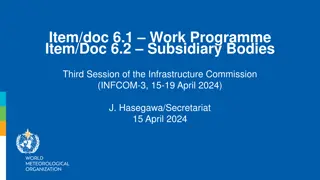
Mastering Time Management Strategies for Success in 12th Grade and Beyond
Learn essential time management skills crucial for academic and professional success, including prioritization, task execution, and time blocking. Explore practical techniques to manage tasks effectively and adapt to changes in priorities. Join this session to enhance your productivity and organizational abilities.
Download Presentation

Please find below an Image/Link to download the presentation.
The content on the website is provided AS IS for your information and personal use only. It may not be sold, licensed, or shared on other websites without obtaining consent from the author. If you encounter any issues during the download, it is possible that the publisher has removed the file from their server.
You are allowed to download the files provided on this website for personal or commercial use, subject to the condition that they are used lawfully. All files are the property of their respective owners.
The content on the website is provided AS IS for your information and personal use only. It may not be sold, licensed, or shared on other websites without obtaining consent from the author.
E N D
Presentation Transcript
Mastering Your Time: Strategies for Success in 12th Grade and Beyond, Sponsored by Everybody Counts
A future way beyond basic. Everybody Counts is a dynamic initiative from Team Kentucky that provides a clear pathway to success for qualifying seniors graduating from participating Kentucky school districts. The initiative benefits graduating seniors as well as businesses, local communities and Kentucky s economy. With Everybody Counts, everybody wins!
Time management, prioritization, and execution of tasks are crucial skills that ensure productivity and success in college, trade school, or the workforce. DESCRIPTION DESCRIPTION This session will cover why it's important and how mastering it can impact your academic, professional, and personal life. We'll explore key aspects like: setting priorities goal setting planning organizing time blocking avoiding procrastination
How can I determine which tasks are truly important and urgent, and 1. KEY QUESTIONS KEY QUESTIONS how do I prioritize them effectively? What are some practical techniques and tools for managing your to do 2. list and tracking progress? How can I adapt my planning and organization strategies to 3. accommodate unexpected events or changes in priorities? What is time blocking and how can it help stay organized? 4. What are the variations in time management practices across different 5. industries and professions?
OBJECTIVES OBJECTIVES Understand how to plan, prioritize, and follow through with the tasks they re faced with each day no matter what pathway you re on. Identifying and prioritizing tasks based on importance and urgency. Tips for time blocking and creating routines and schedules.
Practical techniques to manage your to-do list and track progress effectively, TECHNIQUES TECHNIQUES CAL there are several practical techniques and tools you can use: PRACTICAL Task Breakdown - Break larger tasks into smaller, manageable subtasks to make them less overwhelming and easier to track. PRACTI Prioritization - Use the Eisenhower Matrix or other prioritization methods to focus on tasks that are both important and urgent. Time Blocking - Allocate specific blocks of time for different tasks or types of tasks throughout the day. The Pomodoro Technique - Work in focused intervals (typically 25 minutes) followed by short breaks to maintain productivity and prevent burnout.
Tips for Effective Time Blocking TIME BLOCKING TIME BLOCKING By organizing your day with time blocks, you can ensure that you allocate sufficient time for each task, maintain focus, and avoid the pitfalls of multitasking and distractions. Use Tools: Utilize digital calendars (Google Calendar, Outlook) to set reminders for each time block. Stay Flexible: Be prepared to adjust your schedule if tasks take longer or shorter than expected. Avoid Multitasking: Focus on one task per time block to maximize productivity. Review Regularly: At the end of the day, review your schedule and make adjustments for the next day as needed.
Example Time Blocked Schedule TIME BLOCKING TIME BLOCKING Date: Today 6:00 AM - 7:00 AM - Morning routine (breakfast, getting ready for the day) 7:00 AM - 8:00 AM - Finishing a report due today (focused work session) 8:00 AM - 8:15 AM - Break (short break to refresh) 8:15 AM - 9:15 AM - Finishing a report due today (continued focused work) 9:15 AM - 9:30 AM - Answering a phone call about a non-critical issue (scheduled during a natural break period) 9:30 AM - 10:00 AM - Browsing social media (dedicated time for leisure) 10:00 AM - 11:00 AM - Finishing a report due today (final review and edits) 11:00 AM - 12:00 PM - Planning next week's schedule (time for strategic planning) 12:00 PM - 1:00 PM - Lunch break 1:00 PM - 2:00 PM - Free time or additional tasks (buffer time in case previous tasks take longer) 2:00 PM - 4:00 PM - Work on other important tasks or projects (dedicated work period) 4:00 PM - 4:15 PM - Break (short break to refresh) 4:15 PM - 5:00 PM - Review emails, missed calls, and respond to non-critical issues 5:00 PM - 6:00 PM - Personal time (exercise, hobbies) 6:00 PM - 7:00 PM - Dinner and relaxation 7:00 PM - 8:00 PM - Review the day's accomplishments and prepare for tomorrow
The Eisenhower Matrix One of the most effective tools for prioritizing tasks is the Eisenhower Matrix, also known as the Urgent-Important Matrix. This matrix categorizes tasks into four quadrants: PRIORITIES PRIORITIES SETTING SETTING 1. Urgent and Important: Tasks that need immediate attention and have significant consequences. 2. Important but Not Urgent: Tasks that are important but can be scheduled for later. 3. Urgent but Not Important: Tasks that are urgent but have little impact on long-term goals. 4. Not Urgent and Not Important: Tasks that are neither urgent nor important and can often be eliminated.
Healthcare In healthcare, urgency often takes precedence due to the nature of patient care. Urgent and Important: Emergency surgeries, critical patient care. VARIATIONS VARIATIONS Important but Not Urgent: Continuing education, preventive care programs. Urgent but Not Important: Administrative paperwork that can be delegated. Not Urgent and Not Important: Unnecessary meetings. Daily Work Urgent and Important: Finishing a report due today. Important but Not Urgent: Planning next week's schedule. Urgent but Not Important: Answering a phone call about a non-critical issue. Not Urgent and Not Important: Browsing social media during work hours.
PROCRASTINATION PROCRASTINATION Break-up larger overwhelming tasks into smaller and more manageable steps to help you begin. Focus on one thing at a time. Change your environment - find a productive study environment and minimize AVOIDING AVOIDING distractions. Find a buddy and hold each other accountable. Eat that frog/knock out the hardest task first: Do the hardest, most undesirable task on your to-do list first. Overestimate the amount of time to complete tasks, especially difficult, new, or boring tasks to create buffers or flexibility to your schedule. Create specific, measurable, attainable, relevant, time bound (SMART) goals to work toward. Consider making short- and long-term goals. Set time aside to plan out a weekly schedule based on priorities. Take 5 minutes at the end of the day to write your to-do list for the next day.
1. Set Boundaries Define Work Hours: Stick to a consistent schedule and avoid working beyond your designated hours. 2. Prioritize Self-Care WORK- -LIFE LIFE Schedule Breaks: Integrate short breaks throughout your day to rest and recharge. Engage in Hobbies: Spend time on activities you enjoy outside of work to relax and unwind. BALANCE BALANCE 3. Manage Workload Delegate Tasks: Share responsibilities with colleagues or family members to lighten your load. Learn to Say No: Politely decline additional tasks that would overextend you. WORK 4. Take Care of Physical Health Exercise Regularly: Incorporate physical activity into your routine to boost energy and reduce stress. Eat Healthily: Maintain a balanced diet to support physical and mental health. Get Adequate Sleep: Ensure you get 7-9 hours of sleep each night to rejuvenate your body and mind. 5. Connect with Others Maintain Social Connections: Spend quality time with family and friends to build a supportive network. Seek Professional Help: If needed, consult with a therapist or counselor to manage stress and mental health issues.
OVERVIEW OVERVIEW Implementing these enhanced time management strategies will transform how you manage your day. By setting clear priorities, defining specific goals, planning effectively, organizing tasks, utilizing time blocking, and actively avoiding procrastination, you can optimize your productivity and stay focused on achieving your objectives. This comprehensive approach not only helps you manage your time more efficiently but also enhances your overall effectiveness and well-being.


